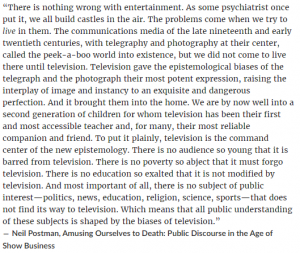Thinking of Sesame Street 35 years ago, it was a big part of my mornings. Filled that time between breakfast and lunch, or more accurately, that time between breakfast and The Flintstones. More recently, as a parent, it became a part of my own children’s mornings, especially in the summer! I felt that it was a nice change up from some of their own choices for screen time, thinking that maybe they could learn something from it. It also felt like maybe something constructive for them to view while I took some time to prep lunch. Other shows like Xavier Riddle, Molly of Denali, and Wild Kratts are still some favourites for my kids. Do they watch it for the content? Maybe. Am I okay with them looking at a screen for a while in the morning while I get my day rolling? Absolutely. Reviewing my own actions through an educator’s lens has me second guessing my own parenting choices through an educator’s lens, and I am okay with that.

Sesame Street Undermines Traditional Schooling?

Postman’s take that undermines traditional schooling comes across as TV replacing human interaction and parents removing themselves from the process. This is where I felt some teacher-parent guilt. In an attempt to justify my aforementioned actions, I did not remove myself from the equation, especially as my kids have gotten older. I actually enjoyed watching with them and questioning them about what they were watching, but I often wondered if they would absorb the information if I did not engage with them. Connecting this to the current classroom, my son will ask to go on his tablet to further investigate a topic or individual who was the focus of episodes he had just watch. Dude is a little Cliff Clavin. I believe that this is what Postman was referring to – relying solely on Oscar, Snuffy, Grover and the gang to educate through entertaining children. Music, song, colours, short segments… make the experience enjoyable and learn through osmosis.
Traditional schooling… all eyes and ears directed at the teacher who is standing at the board at the front of the room. The students, sitting in neat rows, paying close attention to the instruction, then quickly get to work, individually, using the text or other books, and a pencil and paper to make their way through the question. That version of “traditional” education has passed. The new traditional education has taken advantage of continuous upgrades in audio/visual and educational technology to become more student-centred, inquiry-based learning with an emphasis on collaboration. One-to-one technology has allowed students to take control of their own learning, with teachers guiding the process.
Postman also refers to children sitting in front of a screen for “unnatural periods of time” as undermining traditional schooling. Is that not where we have shifted over the last decade? Especially the last 3 years? As society and its reliance on technology changes, education follows suit, often years after the fact. Do students spend “unnatural periods of time” in front of screens today? I would lean towards yes. What about adults? Absolutely (see every Tuesday evening as a small sample). If the education system is in place to teach students to live in society, it makes sense that this shift has occurred.
Related to Culture of Smartphones, BYOD
The classroom that I am in right now, and the Grade 5-8 range provides students with one-to-one technology. I am also working in an affluent school, meaning that accessibility to technology, and the necessary infrastructure is not as major of a concern as it is in other schools. I am aware of the privilege that I experience in this area everyday, and can only hope that my students are as well. Most of the students have cellular phones, increasing their connectedness, not only to education when needed, but the everything that the internet offers (good and bad). This access means that students are able to interact with each other, other students, content, and tools to create content. I do take pride in not relying on the Chromebooks for all of their work, but have noticed a distinct increase in my asking of students to use technology over the past five years.

Larger Implications of Array of AV Technologies
Sunder (2018) recommended the following to get the most out of the use of EdTech or audio/visual tools in the classroom:
- Teachers trained in relevant audio-visual aids
- Make it mandatory for teachers to teach with audio-visual aids
- Fund EdTech adequately
- Parents must be guided in the use of audio-visual aids
- Train, encourage, and support teachers and students in their use of audio-visual aids
- Include audio-visual aids in the curriculum
I agree with the thought of having parents on board and in the loop and training teachers. Comfort breeds success. An important piece of these recommendations is training and supporting students. Digital citizenship is a vital piece of the puzzle, especially as society and education move deeper into the use of EdTech. Postman highlights why understanding appropriate use of audio-visual tools (technology) is important here.

Personalized Tools Change what we might think about school?
Yes, school has changed, and will continue to change in trying to meet the needs of a society that is heavily influenced by technology. The movement to student-centred, inquiry-based learning has changed the roles of school and educators from distributors of information to facilitators of learning. YouTube has changed the game in that students do not necessarily need to consult with a teacher or parent. Help is only a click or a link away. I know that for myself, YouTube has bailed me out of some teaching jams, and allowed me to build my knowledge base and confidence in subjects that have traditionally been stops for the struggle bus. This approach further stresses the importance of critical thinking and understanding reliable resources, something that educators can weave into their lessons. Homeschooling and the pandemic, in addition to natural curiosity, has helped nudge traditional school in this direction, perhaps more quickly that educators have been prepared for. Visiting the traditional idea of school again, was Sesame Street actually ahead of its time in facilitating learning, or was the learning just well-disguised entertainment missing the human facilitator?
I appreciate your thoughts and agree with the teacher training and giving importance to Digital Citizenship. Teaching digital citizenship is more than just having students follow rules, policies, and procedures. Digital Citizenship Education encourages young children to use their knowledge, skills, and understanding in order to protect and promote human rights online, such as freedom, privacy, and security (McGowan 2021).
Definitely ahead of its time, though unknowingly so! I don’t think the show set out to have the cultural impact that it did, but it certainly paved the way for us to analyze different paths to learning. YouTube is almost a modern day Sesame Street for adults and kids alike. I know that it has certainly helped me both professionally and personally. With moving into a house that needed some renos this past year, I learned how to do a variety of tasks simply by watching some videos. I watch enough until I feel confident that I can do the job, and then tend to surprise myself. Of course, this also highlights some of the limitations that using YouTube as a teaching tool – the nature of self-study also limits the guidance that you can receive for assessment along the way. My renos look OK, but don’t look to closely at the fine details because that’s where you’ll see the lack of guidance from having someone there to help me.